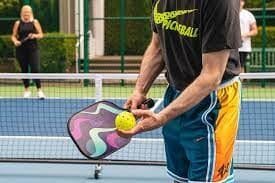Serve Up Safety: Preventing Injuries During Pickleball Training
Pickleball, with its blend of badminton, tennis, and ping pong, has taken the world by storm. Its popularity skyrockets due to its accessibility, social nature, and competitive edge. However, just like any sport, injuries can lurk around the corner for even the most enthusiastic players.
This article serves as your guide to prevent injuries during pickleball training, keeping you safe and active on the court.
Understanding Common Pickleball Injuries:
Before diving into prevention, let’s identify the most common pickleball injuries:
- Rotator cuff and shoulder pain: Repetitive overhead motions put immense stress on the shoulders, leading to rotator cuff tears and tendinitis.
- Wrist and elbow pain: Wrist sprains and carpal tunnel syndrome can arise from improper grip technique and excessive impact.
- Ankle sprains and knee injuries: Sudden stops, changes in direction, and lunges can strain ankles and knees, leading to sprains and tears.
- Achilles tendonitis: This painful inflammation occurs when the tendon connecting your calf muscle to your heel bone is overworked.
- Muscle strains and soreness: Overexertion and improper warm-up/cool-down can lead to muscle strains and soreness, hindering performance and enjoyment.
Prevention is Key: Building a Strong Foundation:
Now, let’s explore strategies to minimize these risks and keep you playing your best:
Preparation:
- Warm-up properly: Spend 10-15 minutes preparing your body with dynamic stretches, light cardio, and gentle movement mimicking pickleball strokes.
- Cool down and stretch: Don’t neglect a 5-10 minute cool-down with static stretches to increase flexibility and prevent post-workout stiffness.
- Listen to your body: Recognize your individual limits and take rest days when needed. Pushing through pain can worsen injuries.
- Stay hydrated: Drink plenty of water before, during, and after training to prevent dehydration, which can contribute to muscle cramps and soreness.
Equipment:
- Choose the right paddle: Select a paddle size and weight suited to your strength and playing style. Avoid overly heavy paddles that strain your wrists and shoulders.
- Wear proper footwear: Invest in supportive court shoes with good traction to prevent ankle rolls and provide stability during quick movements.
- Consider protective gear: Wrist braces and ankle supports can offer additional protection for individuals with previous injuries or specific concerns.
Technique:
- Seek professional guidance: Learn proper form from experienced players or certified coaches to develop sound hitting and footwork techniques.
- Avoid excessive force: Rely on technique and footwork to generate power instead of relying solely on arm strength, which can overload your shoulders.
- Use a relaxed grip: Avoid gripping the paddle too tightly, leading to unnecessary tension and wrist strain.
- Practice footwork drills: Incorporate drills focusing on lunges, shuffles, and quick changes in direction to improve agility and footwork, reducing the risk of ankle injuries.
Strength and conditioning:
- Strengthen key muscle groups: Include exercises targeting your core, legs, shoulders, and upper back to improve stability, power, and injury resilience.
- Focus on balance and agility: Balance exercises and plyometrics can improve your ability to react quickly and maintain stability during play, reducing the risk of falls and ankle sprains.
- Consult a fitness professional: Work with a certified trainer to design a personalized program that addresses your individual needs and goals.
Recovery and Lifestyle:
- Get enough sleep: Adequate sleep is vital for muscle recovery and overall health, preventing injuries and keeping your energy levels high.
- Maintain a healthy diet: Nourish your body with nutritious foods to support muscle repair, energy production, and overall well-being.
- Manage stress: Chronic stress can hinder recovery and contribute to injuries. Explore stress-management techniques like yoga or meditation.
- Listen to your body: Pay attention to any pain or discomfort during or after training. Seek medical attention promptly if necessary.
Remember:
Prevention is always better than cure. By incorporating these tips into your routine, you can minimize the risk of injuries and enjoy your pickleball journey to the fullest. Remember, consistency is key. Make these practices a part of your game, and you’ll be serving up safety and fun well into the future.
Additional Resources:
- American Academy of Orthopaedic Surgeons: https://orthoinfo.aaos.org/: https://orthoinfo.aaos.org/
- American Council on Exercise: https://www.acefitness.org/: https://www.acefitness.org/
- USA Pickleball: https://www.usapickleball.org/: https://www.usapickleball.org/
We hope our readers like above informational.
Thanks for visiting Gymbag4u.com
You may also love reading our following article. Ideal Routine Diets for Athletes – GymBag4U and The Ultimate Athlete’s Guide to Fitness and Healthcare – GymBag4U and The Magnificent Ten: A Look at the Top 10 Bodybuilders in the World (gymbag4u.com)
